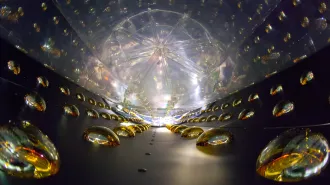
Revving subatomic particles to fantastic speeds within huge accelerators has been a mainstay for physicists probing what makes matter tick. Now, with a novel, table-top machine, scientists say they hope to measure molecular properties with greater precision than before and to assemble molecules into a new type of matter.
For the past 70 years, accelerators have been able to manipulate the speed and energy of only charged particles, such as electrons and ions. A research team led by Gerard Meijer of the FOM Institute for Plasma Physics in Nieuwegein and the University of Nijmegen, both in the Netherlands, has now found a way of applying accelerator techniques to uncharged molecules, such as ammonia, formaldehyde, and water.
In the May 10 Nature, the researchers describe a prototype device, similar to an accelerator, that slows molecules of gaseous ammonia from their ordinary 1,000-meters-per-second velocity to a tenth of that speed. Then, they trapped the slower-moving molecules within hoop-shaped electrodes inside a vacuum chamber.
Future versions of the device should enable the researchers to “play all the tricks with neutral particles that have been played with charged particles,” Meijer says. Among those tricks are both speeding up and slowing down particles, bending their paths, hurling them at targets, and storing them in orbit. All the while, researchers will make measurements to reveal the inner workings of the particles. In the current setup, the molecules dissipate quickly, but the researchers are now working to increase this storage time.
The new machine uses electric fields that interact with the minuscule separations between the internal charges of molecules that are neutral overall. “Basically, any molecule with more than two atoms will work,” Meijer notes.
Rings of slow-moving gas molecules could prove valuable in many ways, comments Phillip L. Gould of the University of Connecticut in Storrs. Besides making better molecular measurements with the device, researchers could use it to precisely deposit molecules to build nanometer-scale structures and circuits.
What’s more, Gould adds, the new device shows promise as a means for making a molecular version of a strange type of matter known as a Bose-Einstein condensate. Such a condensate’s constituent particles share a quantum mechanical state (SN: 2/12/00, p. 104). This exotic form of matter already has enabled scientists to build new kinds of atom lasers and light-manipulating systems (SN: 3/27/99, p. 207). So far, however, they’ve been able to make condensates only from ultracold atoms.
The Dutch experiment “is an important milestone,” comments Harvey A. Gould of Lawrence Berkeley (Calif.) National Laboratory. He and his colleagues are studying the feasibility of building neutral-molecule decelerators considerably larger than the dinnerplate-size ring of Meijer’s group. Efforts to create similar devices failed in the 1950s and 1960s, but improvements in high-voltage switches and other technologies have made the apparatus possible.







